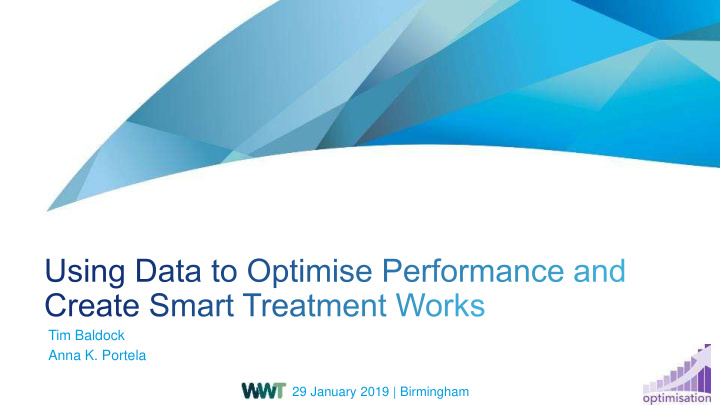



Tim Baldock Anna K. Portela 29 January 2019 | Birmingham
▪ Target of data collection, processing & analysis for Smart Site development ▪ Pla lant-wid ide vis isib ibili lity (via Dashboards) ▪ Key Perf erformance In Indic icators (via Real Time Control) ▪ Oper erati tional In Intell elligen ence ▪ Process optimisation – 10% of sites enabled RTC (upfront costs are high; need for benefit case assessment → offline model) – 90% of sites are dashboarded (to fill gap in RTC installed base; most recent development of 2 nd Generation Dashboard) 2
90 % 10 % RTC Offl fline da dashboards, mod odels 1-2 yrs Modelling for development of business case to 2-5 yrs install online RTC Incremental implementation 5-8 yrs of RTC Achieve maturity in building offline/online dynamic models for Dashboards and RTC 8-10 yrs applications Fully con Fully onverged 100 % “Smart Site” 3
• Spot samples Field Data • Real-time process data for back-end and Source inter-stage monitoring Telemetry / PI System • Historical events analysis • PI tags Telemetry + Field Data Intelligent Data Management • Telemetry + Field Data- enabled to track KPI Dashboards Data • Past & present- “black - box” models (averaged historical data Points and rule-of-thumb empirical process efficiencies) Models • Present & future- dynamic, transparent plant-wide models (telemetry + field data) for RTC 4
▪ Spot samples- SAP BI Sample Reports ▪ Telemetry data- PI Datalink ▪ Dynamic visualisation the data-time series ▪ PI Process Book & Prism 5
▪ Telemetry + Field Data used to build KPI-driven dashboards ▪ Red/ Amber/ Green Status for KPIs (Performance Management) ▪ Enables Operations to achieve Operating Plan targets ▪ Continuous process improvement STC 1 STC 2 STC 3 STC 4 STC 5 STC 6 STC 7 STC 8 STC 9 STC 10 STC 11 STC 12 STC 13 STC 14 STC 15 STC 16 6
▪ Pre-Dashboard ▪ look-up target sheet 1 st generation Dashboard ▪ ▪ Involves threshold data analysis (against the target value) ▪ Data sources: telemetry data; operating plan 2 nd generation Dashboard ▪ ▪ involves linear and non-linear regression analysis ▪ data sources: black-box model outputs; telemetry & field data; design parameters 3 rd generation Dashboard ▪ as 2 nd generation Dashboard + dynamic model outputs (future Dashboard) ▪ ▪ inked Da Dash shboards Ultimate target – rob obust RTC via interlin 7
▪ Generation of the improved MLSS Dashboard Morestead Road Winchester MLSS Existing 1 st Generation MLSS Dashboard 4500 4000 3500 3000 Telemetry data 2500 2000 1500 Operating plan targets 1000 500 0 11/12/18 16/12/18 21/12/18 26/12/18 31/12/18 05/01/19 10/01/19 15/01/19 20/01/19 Lane 1 Lane 2 Lane 3 Minimum Maximum ▪ Determine costs of running Activated Sludge plants outside the operating MLSS range set in the operating plan ▪ Identify benefits/spend comparing to the baseline 8
Inputs Outputs Operating plan targets Set the MLSS baseline Telemetry / PI Datalink Operating plan targets Physical design parameters Black-box model Telemetry / PI Datalink Sample reports Unit energy costs £/kWh = f (MLSS) Output analysis Physical design parameters Linear regression 2 nd Generation Dashboard Method verification Analytical formulation 9
▪ Site selection ▪ Size, process type (carbonaceous, nitrifying, BNR,...) and asset type (diffused air system, mechanical/surface aeration) ▪ Model output ▪ Energy demand on aeration as a function of MLSS concentration ▪ Data sources: PI Datalink, spot sample results, O&M manuals, operating plan ▪ Calculations performed for over 30 sites ▪ Slope-intercept form of each E =f( MLSS ) curve were consecutively analysed and compared against process design parameters 10
▪ Linear regression analysis- employed to determine possible correlations of the data sets with process design parameters ▪ The accuracy of the correlation developed for energy demand computation was validated against the values originated from the oxygen demand calculators 11
▪ Energy expenditures determined for the actual MLSS concentration- identification of potential benefits/costs comparing to the baseline ▪ Up to date- dash boarded 56 sites 2 nd Generation MLSS Dashboard ▪ £300k/year benefit identified Total variance over month Operating plan targets Baseline Telemetry data 12
▪ Plant-wide modelling WTW & STC ▪ SW Team: Optimisation and Process Capacity & Modelling ▪ University of Portsmouth 13
WTW & STC model- identify quick win concepts & verify benefits from “black - box” mass balance models ▪ BioWin ▪ Evaluation of the unit process efficiencies & overall treatment performance ▪ Costs analysis for different operating scenarios (flows and loadings, choice of alternative C source for BNR) ▪ BW Controller ▪ Evaluation of the existing control philosophy & its optimisation towards more sustainable control strategies (e.g. DO, N-DN and SRT control, recycle rates, chemical dose rates, etc.) 14
Data points sources ▪ Physical details & operating parameters ▪ O&M Manuals, Drawings ▪ PI Datalink ▪ Prism ▪ Field data ▪ Dedicated sampling campaign ▪ Spot sample database Goo ood qualit lity data required for model calibration and validation! 15
Hourly power cost 16
17
▪ Risk-free evaluation of different operating scenarios for effective optimisation ▪ Process performance under variable flow and loading conditions ▪ Changes in process parameters, configuration and control philosophy ▪ Re-assessment of the potential benefits & additional costs ▪ Biogas production ▪ Energy demand on aeration ▪ Optimised chemical dosing and tankering ▪ Capex required for optimised treatment performance ▪ Key innovations ▪ Use of plant- wide dynamic models for Dashboards and RTC for “Smart Sites” 18
19
Recommend
More recommend